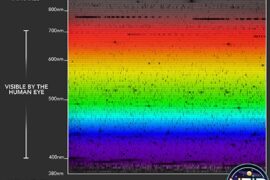Astronomers, including UCI’s Paul Robertson, recently began the scientific mission of developing the new NEID spectrometer. Attached to the WIYN 3.5-meter telescope at Kitt Peak National Observatory in Arizona, the instrument will aid in the discovery of planets outside of our solar system.
NEID measures with extreme precision the gravitational wobble planets exert on their host stars. The tool lets observers detect changes in speed of a star’s motion of less than 50 centimeters per second.
“This allows us to detect the orbital motions of planets as small as Earth and discern if these bodies are in the habitable zone with liquid water,” said Robertson, UCI assistant professor of physics & astronomy, one of two NEID project scientists.
“Gravitational wobble tells us a planet’s mass; a more massive planet will create a bigger wobble,” he added. “We can use NEID to measure masses of planets that transit, or eclipse, their stars. The transit gives an estimate of the planet’s radius which, combined with the mass, yields information about the planet’s density, and that’s what helps us determine whether it’s rocky like Earth or has a more massive atmosphere.”
Robertson designed and carried out the commissioning plan for NEID which helped the team make sure the instrument functions as intended. Now that the scientific mission has begun, he and his lab members are part of a collaboration that is guaranteed 30 nights per year of observing time for the next five years.
“Students and postdocs from my group at UCI will conduct their own research projects using data gathered during the guaranteed time observing survey, and some have already received competitively awarded time on NEID to conduct their own experiments,” Robertson said.
He added that for some projects, his group will combine data from NEID, which operates in visible light, with that gathered by the infrared light-detecting Habitable-zone Planet Finder, an instrument Robertson also helped to commission. While NEID is well-suited for discovering exoplanets orbiting stars like our sun, HPF, situated at the 10-meter Hobby Eberly telescope at McDonald Observatory in Texas, is optimized for cooler “M dwarf” stars.
“But since NEID can access a very wide range of visible wavelengths, it can do powerful science on M dwarfs, as well,” he said.
Robertson added that one of his favorite things about NEID is its name.
“It’s not an acronym; NEID is actually a word used by the Tohono O’odham tribe which holds Kitt Peak as a place of sacred significance,” he said. “Pronounced ‘noo-id,’ it means ‘to see’ in their language.”


